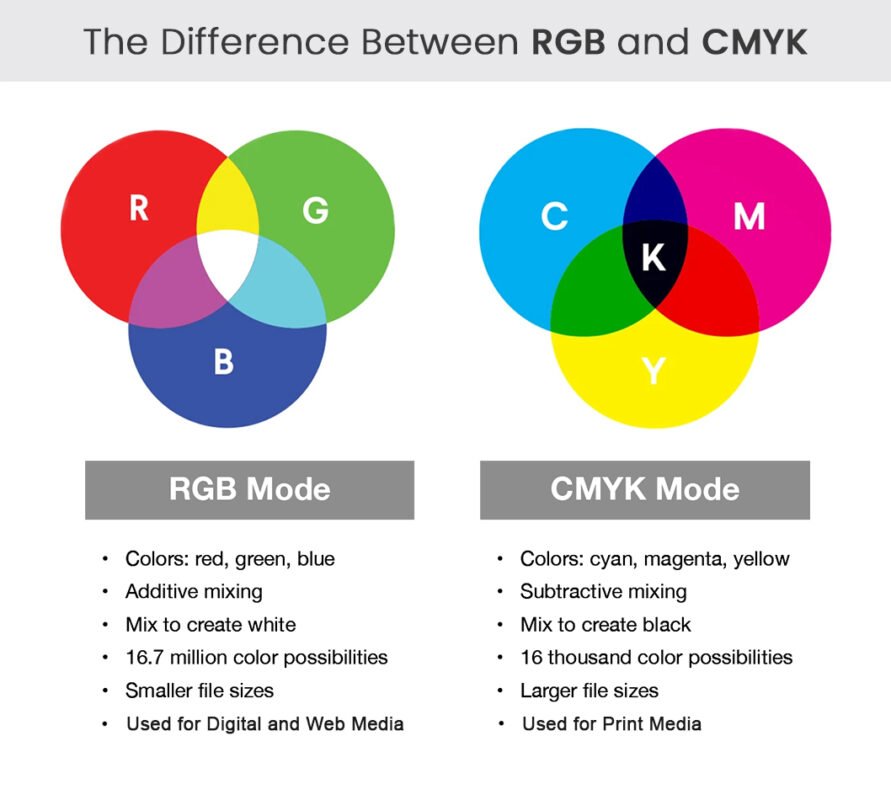Uncategorized
Just another post with A Gallery
In the world of digital and print media, color plays a crucial role in how your brand is perceived. As a printing shop, we often encounter questions about the difference between CMYK and RGB color modes, and why it’s essential to use the correct one for various projects. In this blog, we’ll dive deep into the key differences between CMYK and RGB, their specific uses, and why RGB colors are unsuitable for offset printing.
What Are CMYK and RGB?
CMYK stands for Cyan, Magenta, Yellow, and Key (Black). This color model is primarily used in color printing. These four colors are combined in various ways to produce a wide range of colors. The process involves subtracting light from a white background, meaning the colors are created by masking light.
RGB stands for Red, Green, and Blue. This color model is used for digital displays such as computer monitors, televisions, and cameras. RGB is an additive color model, which means it creates colors by adding light together. When the primary colors (red, green, and blue) are combined at their full intensity, they produce white light.
Key Differences Between CMYK and RGB
-
Color Formation:
- CMYK: Subtractive process. It starts with a white background and subtracts light to create colors.
- RGB: Additive process. It starts with a black background and adds light to create colors.
-
Primary Use:
- CMYK: Used for print media, such as brochures, business cards, posters, and magazines.
- RGB: Used for digital media, such as websites, online graphics, and digital advertisements.
-
Color Range:
- CMYK: Has a smaller color gamut compared to RGB. Some bright colors, especially neon and certain shades of blue and green, cannot be replicated accurately in CMYK.
- RGB: Offers a wider color gamut, allowing for more vibrant and varied colors.
Why RGB Colors Are Not Suitable for Offset Printing
When it comes to offset printing, using RGB colors can lead to disappointing results. Here’s why:
-
Color Conversion Issues:
- Offset printing uses the CMYK color model. If your artwork is in RGB, it needs to be converted to CMYK. This conversion can cause significant color shifts because the RGB color gamut is larger than CMYK. Bright and vibrant colors in RGB may appear duller and less saturated in CMYK.
-
Inaccurate Color Reproduction:
- Colors that look great on screen (RGB) may not print as expected. For instance, a bright blue on your computer screen might turn out to be a muted blue in print. This discrepancy can affect the overall look and feel of your printed materials.
-
Professionalism and Consistency:
- For a professional and consistent output, it’s crucial to design in the color space your final product will be produced in. Designing directly in CMYK ensures that the colors you see on your screen are closer to what will appear in print, leading to fewer surprises and a more reliable print result.
Importance of Using the Correct Color Mode
Understanding the difference between CMYK and RGB is essential for anyone involved in the design and printing process. Here are a few reasons why:
-
Accurate Color Representation: Using the correct color mode ensures that your colors are represented accurately, whether on screen or in print. This is vital for maintaining brand consistency and ensuring that your materials look professional.
-
Cost-Effectiveness: Designing in the correct color mode can save you money. It reduces the need for multiple proof prints and minimizes the risk of costly reprints due to color discrepancies.
-
Efficiency in Workflow: Knowing when to use CMYK or RGB streamlines your design and printing workflow. It prevents unnecessary delays caused by color conversion issues and ensures a smoother transition from digital design to printed product.
Conclusion
Choosing the right color mode for your project is a critical step in achieving the best results. While RGB is perfect for digital designs, CMYK is the go-to for print. By understanding and applying this knowledge, you can ensure that your printed materials are vibrant, professional, and true to your vision. At our printing shop, we’re always here to help you navigate these choices and produce the highest quality prints for your needs. Contact us today to learn more about our services and how we can assist you with your next printing project!


